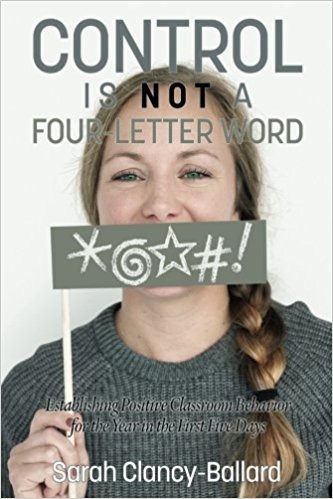discipline
Select an item by clicking its checkbox

Control is Not a Four-Letter Word!: Establishing Positive Classroom Behavior for the Year in the First Five Days
Date Reviewed: January 23, 2019
Control is Not a Four Letter Word provides an abundance of helpful information for everyone from the first-time teacher to the veteran teacher. After forty years of classroom experience, Sarah Clancy-Ballard bridges the gap between learning how to teach and establishing classroom authority. She believes a teacher sets the tone for the entire year in the first five days of a new school year (xii). The resonating theme of the text is that classroom control emerges from preparation and “the depth of commitment the teacher has to control the class” (xiii). The author examines the importance of first impressions, organizing and utilizing the written word, time management, and behavior management.
Clancy-Ballard’s classroom teaching experience leads her to believe the secret to classroom management is a teacher’s ability to control their classroom when students feel that the teacher cares for them on a personal level (6). The author notes facial expression and remembering student names are the most important things a teacher can to do to set the tone and communicate interest in students as individual people. She values relationship building both inside and outside of the classroom as a vital part of a teacher’s educational philosophy. Clancy-Ballard stresses that teachers need to form relationships with janitorial staff, fellow teachers, and administrative staff, and encourages new teachers to watch “veteran teachers: what works and does not, and how it changes with each principal” (33). She provides a detailed look at how to organize the classroom space, utilize textbooks, handouts, and instructional boards, and create a daily classroom routine. The book covers dozens of examples of routine-driven agendas, inspiring readers to “establish a routine for the beginning of class” (46).
Clancy-Ballard equips the reader with clear guidelines for implementing evaluation methods and time management within the classroom. She associates teacher time management and student assessment to classroom behavior management, pointing once again to the importance of preparation. The author emphasizes that “the student’s attitude about himself or herself and you is directly related to how he or she perceives they are doing in class,” thus connecting the teacher’s behavior to the student’s achievements (55). She encourages teachers to take inventory of their strengths and weaknesses, understanding how their “behavior in class will directly impact the behavior” of their students (66). Clancy-Ballard proposes a benevolent dictatorship approach in the classroom – treating students as intelligent individuals who have ownership of classroom management. By beginning the school year with clear expectations and explaining why the guidelines are instrumental to the class’s success, the teacher can establish control through preparation characterized by benevolent dictatorship (71).
Control is Not a Four Letter Word is primarily written for first-time elementary school teachers; however, it can be a useful reference guide for teachers from elementary through high school. This book is a useful asset for school principals to utilize with teachers for discussion about the numerous reflection questions. This could help ensure appropriate application rises from knowledge.
Professors at the undergraduate level, will find Control is Not a Four Letter Word a helpful tool to assist senior-level students as they leave the classroom and begin student teaching. During the first half of the school year, student teachers would benefit by using the text’s key concepts to observe and evaluate the lead teacher and their level of classroom control. By the second half of the year, student teachers would be well versed in the key concepts, and thus prepared to apply Sarah Clancy-Ballard’s methods in the classroom.